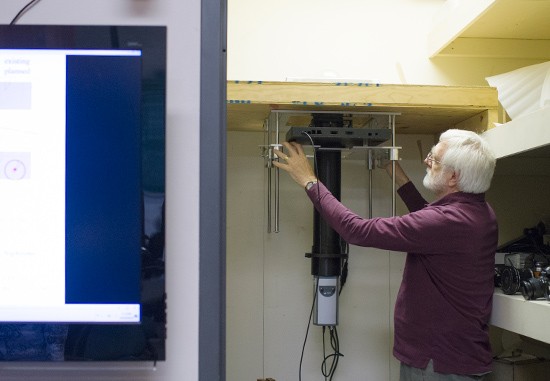Who says you can’t be two places at the same time?
At an MIT observatory west of Boston, a BU-built, three-foot-long, tubular camera stares with feline patience at the ionosphere, the electrically charged portion of the Earth’s upper atmosphere. On the other side of the world, a similar device stargazes from frozen Antarctica. The two are opposite each other along the same magnetic field line (the line along which forces of magnetic attraction and repulsion move). Whenever a disturbance creases the ionosphere, the two devices simultaneously capture what it looks like, as seen from two different hemispheres (and two different seasons, since it’s summer there when it’s winter here, and vice versa).
Isolated cameras long have recorded ionospheric disruptions from one spot, says Michael Mendillo, a College of Arts & Sciences astronomy professor. But “these effects behave differently in different seasons. And so if you studied the effect in the Northern Hemisphere, you’d get a different effect in the Southern Hemisphere—same night, same disturbance.” For a decade, BU’s Imaging Science Laboratory, headed by Mendillo (GRS’68,’71), has girdled the globe with about a dozen such devices, most of them paired with another along the same magnetic line. Sensors in South Carolina, Puerto Rico, and Columbia are linked along magnetic lines to three different sensors in Argentina. One in Italy soon will be partnered with another in South Africa.
“This camera here is about a $25,000 item,” says Jeffrey Baumgardner, sounding like a proud father showing off his newborn as he opens a closet in the Imaging Science Laboratory to display the South Africa–bound sensor. The lab’s senior research scientist, Baumgardner (GRS’77) builds the sensors. (They’re not backyard adornments; most are housed at observatories.) The Antarctic device is the only one he didn’t construct; the lab is piggybacking off a sensor there run by a colleague at Utah State.
Mendillo’s lab began the research on the realization that a ripple in the ionosphere enters different hemispheres along the same magnetic lines, and that to understand the phenomenon requires two sets of eyes. “If we studied summer effects in one hemisphere and waited for winter effects in the same hemisphere six months later, the source of the disturbance—say, a geomagnetic storm—would be different,” the professor says.

Baumgardner built a dozen cameras to take images of the ionosphere from different points on Earth.
The project is basic science and is in the fourth year of a five-year, $1.8 million National Science Foundation grant. Yet there’s a practical application, too, such that the Defense Department is kicking in funding: ionosphere disruptions monkey with radio transmissions. “There have literally been stories where an airman is listening on the radio and it’s going static, so he’ll hit the receiver,” says Mendillo, but “there’s nothing wrong with the electronics; the problem is in the ionosphere.” The project might help the military figure out areas to avoid in sending radio signals. “If a radio wave passes through a disturbance, it scintillates like crazy, and you can lose the information that you want to get,” he says, from voice communications to GPS reception.
With pictures taken every 10 minutes or so all night long, the sensors allow the lab to compare similarities and differences of the same disruption in different seasons, Mendillo says. For example, he points to a series of snapshots taken from Massachusetts and Antarctica on a June day in 2013: an aurora is seen in both, but its boundaries are different, with the Southern Hemisphere version much brighter. “Could it be because it’s summertime here and it’s wintertime down there, and the solar radiation that makes the ionosphere is weaker in one season or the other?” he asks, previewing the kind of questions the research seeks to answer.
Why not probe the ionosphere from space? After all, the international space station orbits in it, Mendillo says. But the station isn’t stationary, he notes; it passes through regions, making lengthy observations impossible. “An instrument from the ground only measures the local ionosphere, but it does it continuously,” all night. “It gives us an image of where the ionosphere is being disrupted.”
The Antarctic setup, surprisingly, might have been the easiest to arrange. Having to line up systems spanning the globe has introduced the lab to the nonscientific chores of figuring currency differences, varying import duties, and the like. “Oh God,” Mendillo moans, “the logistics are just unbelievable.”
Mendillo and members of his lab—Baumgardner, Carlos Martinis (GRS’01,’06), a CAS research assistant professor of astronomy, senior research scientist Steven Smith, and senior staff researcher Joei Wroten—are preparing new funding requests to enable them to spend the next 5 to 10 years analyzing the raw data. “While I get to be called the principal investigator of the grants,” says Mendillo, “what I like to call the A-Team of the Imaging Science Lab actually made it happen,” now “helping to transform a big data source into forefront yields of space science.”














































Related Stories
Looking for Extraterrestrial Life? Here’s a New Target
Charged oxygen in ionosphere may offer biomarker for exoplanets
As Mars Goes, So Goes Earth?
BU-aided NASA mission to explore sun’s effects there, and maybe here
Two BU Scientists Win Sloan Fellowships
Astronomer Catherine Espaillat, physicist Alex Sushkov
Post Your Comment